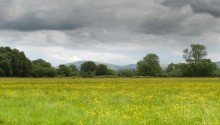Today’s walk took us from the Mill, just east of Sturminster Newton along the River Stour, walking upstream. We had originally intended to walk as far as the outskirts of the town, returning along the old railway line. But in spite of the fact that we could hear a cuckoo calling from that direction, we never managed to leave the river as there was so much too see!
It was a cold morning and consequently we didn’t really expect to see many insects, but right from the start we were amazed by the amount of life over the river. Most obvious were the swarms of what looked like tiny black moths, but were probably caddis flies. Occasionally catching and eating them were several red-eyed damselflies, only the second time I had ever seen this fairly local species.
The path we were walking along bordered a superb wild flower meadow, containing an enormous density of meadow buttercups and seven different species of grass. In the river itself were patches of yellow water-lilies and some very impressive bul-rushes (actually a type of sedge).
Forming a swathe between the river and the field was a wide patch dominated by tall plants such as umbellifers. In the wetter patches these were mostly hemlock water-dropworts with other areas containing hogweed and cow parsley. All these plants are very important nectar sources for insects and today various flies were in abundance, particularly the colourful noon fly. A large beetle found here had to be photographed and submitted to iSpot for identification. We could se it was one of the Cantharis species but we could not be sure which one. Check out the iSpot page at https://www.ispot.org.uk/node/267800 to see if the experts have come to a decision. The stands of water dropwort at one bend in the river had a small colony of the amazingly beautiful banded demoiselle, frustratingly too quick for a photo even in this cold weather.
Returning to the picturesque waters of Fiddleford Mill we realised that the mill stream was full of fish. Never easy to identify looking through the water surface we definitely saw the stripey flanks of a couple of small perch along with a number of larger specimens with very bright red fins, probably rudd, along with a few duller fish that might have been dace or perhaps chubb.
And not a butterfly seen all morning – in June!
Bob Ford
https://www.dorsetwalks.com
Insects
Caddis Fly
Red-eyed Damselfly
Banded Demoiselle
Green Drake Mayfly? (see https://www.ispot.org.uk/node/267659 )
Noon Fly
Scorpion Fly
Drone-fly
Marmalade Hoverfly
Bee Hoverfly
Dock Beetle
Birds
Buzzard
Mallard
Great Spotted Woodpecker
Cuckoo (heard)
Wood Pigeon
Swift
Swallow
Blackcap (heard)
Chiffchaff (heard)
Great Tit
Robin
Blackbird
Mistle Thrush
Chaffinch
Fish
Rudd
Dace
Perch
Plants
Yellow Water-lily
Meadow Buttercup
Red Campion
Hemlock (see https://www.ispot.org.uk/node/267702 )
Hemlock Water-dropwort
Cow Parsley
Hogweed
Pignut
Cut-leaved Cranesbill? (see https://www.ispot.org.uk/node/267684)
White Dead-nettle
Red Clover
Bush Vetch
Ground Ivy
Welted Thistle
Cocksfoot
Meadow Foxtail
Yorkshire Fog
Meadow Grass
Rye Grass
Crested Dogstail
Soft Brome
Bul-rush







